
Hutia

The following seven Plagiodontia species apparently lived during Recent times:
In P. aedium head and body length is about 312 mm and tail length is about 153 mm. The listed adult weight as 1,267 grams. In P. hylaeum head and body length is 348-405 mm and tail length is 125-45 mm. Judging from the skeletal remains, the largest species in the genus is P. ipnaeum and the smallest is P. spelaeum. In the living species, the short, dense pelage is brownish or grayish on the upper parts and buffy on the underparts. The tail is scaly and practically naked. Both the forefoot and the hind foot have five digits, all armed with claws except the thumb, which has a short, blunt nail. Females have three pairs of lateral thoracic mammae.
Hispaniolan hutias (hoo-TEE-ah) inhabit forests. It is reported that they occupy rough hillsides and ravines from sea level to 2,000 meters in elevation, that some populations use burrows and feed near the ground, and that other populations may den in tree cavities and move through the trees, rather than come to the ground. Captives have been observed to be nocturnal and arboreal and to use nest boxes placed high off the ground. Wild P. aedium were reported to be active only at night, to hide during the day, to feed principally on roots and fruits, and to live in male-female pairs. Reports also stated that three or four individuals commonly occupy the same burrow system. Specimens of P. hylaeum were caught in December in hollow trees near a lagoon; four pregnant females each contained a single embryo. Purportedly, captive female P. aedium have an estrous cycle of 10 days, a gestation period of 119 days, and apparently a single offspring. Recorded gestation has been 123-50 days and litter sizes of one to two young in this species. A captive P. aedium was still alive after 9 years and 11 months.
Five of the seven species in this genus are known only by skeletal remains, often found in association with human kitchen middens. These five species probably disappeared by the seventeenth century because of excessive hunting by people. P. aedium and P. hylaeum have been greatly reduced in range and numbers and are threatened by deforestation, hunting, and predation by the introduced mongoose (Herpestes auropunctatus). The human population of Hispaniola is increasing, most of the island's forest cover is being cleared for agriculture, and hutias are killed whenever encountered. The IUCN regards P. hylaeum as a subspecies of P. aedium and classifies the latter as indeterminate. Recent surveys in Haiti have found P. aedium to be somewhat more common than once feared, though still in jeopardy, and also have received reports of the possible survival of P. velozi
Hutias belong to the order Rodentia and the Capromyidae family.

Taken from Hispaniolan Hutias. Adapted by Miguel E. Rodríguez.
Press here for information about copyrights.
You are visitor number  to view this page.
to view this page.
Back to Wild Life of the Republic